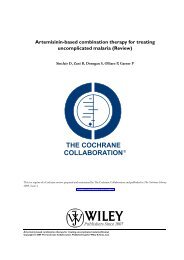Antiamoebic drugs for treating amoebic colitis - The Cochrane Library
Antiamoebic drugs for treating amoebic colitis - The Cochrane Library
Antiamoebic drugs for treating amoebic colitis - The Cochrane Library
Create successful ePaper yourself
Turn your PDF publications into a flip-book with our unique Google optimized e-Paper software.
analysed the participants as one group (Misra 1974; Tripathi<br />
1986).<br />
• ◦ Thirteen trials recruited and analysed participants with<br />
symptoms of intestinal amoebiasis or <strong>amoebic</strong> <strong>colitis</strong> together,<br />
regardless of whether they presented with dysentery or not.<br />
Participant age<br />
Participant age ranged from seven months to 80 years; see<br />
Appendix 7 <strong>for</strong> details. Adults only (ie those aged more than 15<br />
years) were recruited in 15 trials, while 10 trials recruited only<br />
children. Both adults and children were recruited in the remaining<br />
10 trials. Participant age was not stated in two trials (Kapadia<br />
1968; Batra 1972).<br />
Methods used to diagnose <strong>amoebic</strong> <strong>colitis</strong><br />
Stool microscopy with direct smear was used as the predominant<br />
method <strong>for</strong> determining the presence of E. histolytica cysts<br />
or trophozoites in stools (details in Appendix 8): concentration<br />
methods <strong>for</strong> better detection of cysts (16 trials); flotation technique<br />
(two trials); and polyvinyl alcohol fixative <strong>for</strong> the detection<br />
of trophozoites (one trial). One trial used stool culture <strong>for</strong> E. histolytica<br />
in addition to stool microscopy to evaluate parasitological<br />
response, but it was not used as an inclusion criterion in the trial<br />
(Batra 1972). Only one trial used stool antigen-based ELISA test<br />
(Rossignol 2007).<br />
Concomitant infection with other intestinal parasites<br />
Aside from E. histolytica, concomitant infection with other intestinal<br />
parasites was identified in 10 trials: giardiasis (Singh 1977;<br />
Prasad 1985; Tripathi 1986; Rossignol 2001); intestinal helminth<br />
infection (Pudjiadi 1973; Panggabean 1980; Sitepu 1982); and<br />
other intestinal protozoa and helminth infection (Pehrson 1983;<br />
Salles 1999; Davila 2002). Three trials explicitly stated that stool<br />
bacterial culture was done be<strong>for</strong>e enrolment and excluded those<br />
found to be positive <strong>for</strong> pathogenic bacteria (Toppare 1994;<br />
Karabay 1999; Rossignol 2007). Concomitant infection with<br />
other intestinal pathogens or bacteria was not examined or not<br />
mentioned in the remaining trials. Since clinical symptoms may<br />
not have been exclusively caused by amoebiasis in those with concomitant<br />
intestinal parasites and the effect of concomitant infection<br />
on eradication of E. histolytica by anti<strong>amoebic</strong> <strong>drugs</strong> is not<br />
known, data <strong>for</strong> E. histolytica infection alone were used in assessment<br />
of outcomes except in those trials that did not separate the<br />
data <strong>for</strong> those with single and mixed infections. Separate analysis<br />
<strong>for</strong> clinical outcomes <strong>for</strong> those with E. histolytica alone and those<br />
with concomitant infection with Giardia and E. histolytica was<br />
carried out in three trials (Prasad 1985; Rossignol 2001; Davila<br />
2002).<br />
Drug comparisons<br />
<strong>The</strong> included trials contained a variety of comparisons and involved<br />
over 30 individual <strong>drugs</strong> and combinations. As shown in<br />
Appendix 9, we grouped the trials into the following categories<br />
(some trials are included in more than one category):<br />
• single agent alternative versus metronidazole (17 trials);<br />
• any anti<strong>amoebic</strong> drug versus placebo (four trials);<br />
• combination regimen versus monotherapy (seven trials);<br />
• single-dose regimens versus longer regimens (five trials); and<br />
• other <strong>amoebic</strong> drug comparisons (nine trials).<br />
More than two interventions were compared in six trials. Three<br />
trials compared different doses of the same <strong>drugs</strong> with standard<br />
or control groups: three dosages of quinfamide with placebo in<br />
Huggins 1982; two treatment durations of tinidazole with metronidazole<br />
in Awal 1979; and four dosages of MK-910 in Batra 1972.<br />
Ten different treatment groups were compared with placebo in<br />
Donckaster 1964, and three <strong>drugs</strong> used alone or in three different<br />
combinations were compared in Pamba 1990. Two brands of<br />
tinidazole and two brands of metronidazole were compared in one<br />
trial (Chunge 1989). For trials with more than two intervention<br />
groups, we combined multiple treatment arms as appropriate in<br />
one group and compared them collectively with the standard or<br />
control group. This is the recommended approach to avoid a unit<br />
of analysis error by not counting the placebo or control participants<br />
more than once in the same meta-analysis (Higgins 2008).<br />
For the trial comparing two brands of tinidazole and two brands<br />
of metronidazole, the two brands of tinidazole were combined as<br />
one group and compared with the two brands of metronidazole<br />
in the other group.<br />
Duration of follow up<br />
<strong>The</strong> follow-up period varied considerably between trials. Seventeen<br />
trials were followed up <strong>for</strong> about one month. Four trials were<br />
followed up only until the end of the treatment period (Kapadia<br />
1968; Batra 1972; Pudjiadi 1973; Asrani 1995). Duration of follow<br />
up was less than 15 days in 10 trials (Huggins 1982; Sitepu<br />
1982; Prasad 1985; Chunge 1989; Toppare 1994; Mohammed<br />
1998; Padilla 2000; Rossignol 2001; Davila 2002; Rossignol<br />
2007), while the longest period was 12 months (Nnochiri 1967).<br />
Outcome measures<br />
<strong>Anti<strong>amoebic</strong></strong> <strong>drugs</strong> <strong>for</strong> <strong>treating</strong> <strong>amoebic</strong> <strong>colitis</strong> (Review)<br />
Copyright © 2009 <strong>The</strong> <strong>Cochrane</strong> Collaboration. Published by John Wiley & Sons, Ltd.<br />
<strong>The</strong> primary outcomes in this review were clinical failure, parasitological<br />
failure, and relapse. Thirty-one trials evaluated both clinical<br />
and parasitological outcomes, and six trials evaluated parasitological<br />
outcomes only (Donckaster 1964; Nnochiri 1967; Pehrson<br />
1983; Pehrson 1984; Padilla 2000; Davila 2002). <strong>The</strong> definition of<br />
clinical and parasitological cure or failure in the trials varied. Nine<br />
trials (Misra 1974; Joshi 1975; Mathur 1976; Misra 1977; Singh<br />
1977; Swami 1977; Misra 1978; Awal 1979; Tripathi 1986) used<br />
the definitions set by the WHO Expert Committee on Amoebiasis<br />
9








